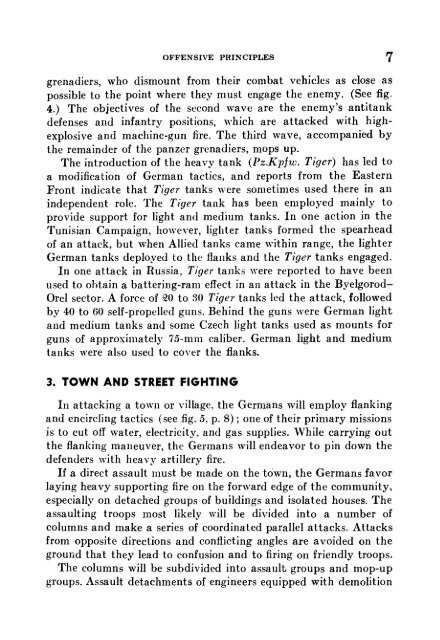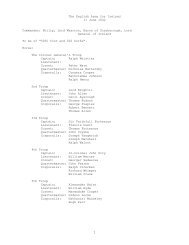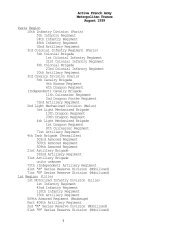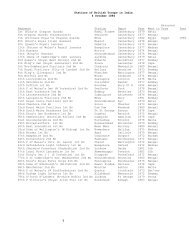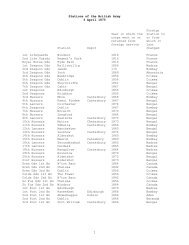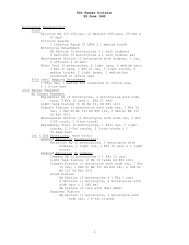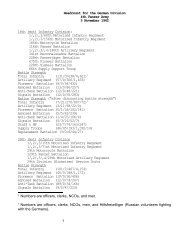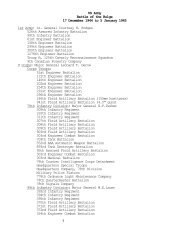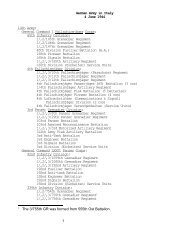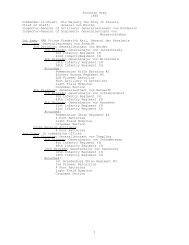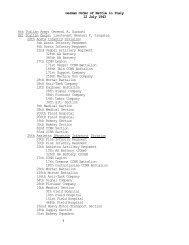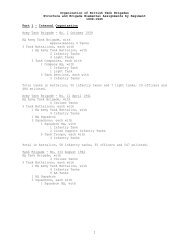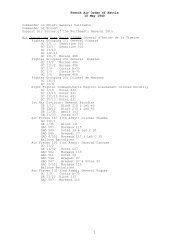Company Officer's Handbook Of The German Army - Command and ...
Company Officer's Handbook Of The German Army - Command and ...
Company Officer's Handbook Of The German Army - Command and ...
Create successful ePaper yourself
Turn your PDF publications into a flip-book with our unique Google optimized e-Paper software.
OFFENSIVE PRINCIPLES 7<br />
grenadiers, who dismount from their combat vehicles as close as<br />
possible to the point where they must engage the enemy. (See fig.<br />
4.) <strong>The</strong> objectives of the second wave are the enemy's antitank<br />
defenses <strong>and</strong> infantry positions, which are attacked with highexplosive<br />
<strong>and</strong> machine-gun fire. <strong>The</strong> third wave, accompanied by<br />
the remainder of the panzer grenadiers, mops up.<br />
<strong>The</strong> introduction of the heavy tank (Pz.Kpfw. Tiger) has led to<br />
a modification of <strong>German</strong> tactics, <strong>and</strong> reports from the Eastern<br />
Front indicate that Tiger tanks were sometimes used there in an<br />
independent role. <strong>The</strong> Tiger tank has been employed mainly to<br />
provide support for light <strong>and</strong> medium tanks. In one action in the<br />
Tunisian Campaign, however, lighter tanks formed the spearhead<br />
of an attack, but when Allied tanks came within range, the lighter<br />
<strong>German</strong> tanks deployed to the flanks <strong>and</strong> the Tiger tanks engaged.<br />
In one attack in Russia, Tiger tanks were reported to have been<br />
used to obtain a battering-ram effect in an attack in the Byelgorod-<br />
Orel sector. A force of 20 to 30 Tiger tanks led the attack, followed<br />
by 40 to 60 self-propelled guns. Behind the guns were <strong>German</strong> light<br />
<strong>and</strong> medium tanks <strong>and</strong> some Czech light tanks used as mounts for<br />
guns of approximately 75-mm caliber. <strong>German</strong> light <strong>and</strong> medium<br />
tanks were also used to cover the flanks.<br />
3. TOWN AND STREET FIGHTING<br />
In attacking a town or village, the <strong>German</strong>s will employ flanking<br />
<strong>and</strong> encircling tactics (see fig. 5, p. 8); one of their primary missions<br />
is to cut off water, electricity, <strong>and</strong> gas supplies. While carrying out<br />
the flanking maneuver, the <strong>German</strong>s will endeavor to pin down the<br />
defenders with heavy artillery fire.<br />
If a direct assault must be made on the town, the <strong>German</strong>s favor<br />
laying heavy supporting fire on the forward edge of the community,<br />
especially on detached groups of buildings <strong>and</strong> isolated houses. <strong>The</strong><br />
assaulting troops most likely will be divided into a number of<br />
columns <strong>and</strong> make a series of coordinated parallel attacks. Attacks<br />
from opposite directions <strong>and</strong> conflicting angles are avoided on the<br />
ground that they lead to confusion <strong>and</strong> to firing on friendly troops.<br />
<strong>The</strong> columns will be subdivided into assault groups <strong>and</strong> mop-up<br />
groups. Assault detachments of engineers equipped with demolition


